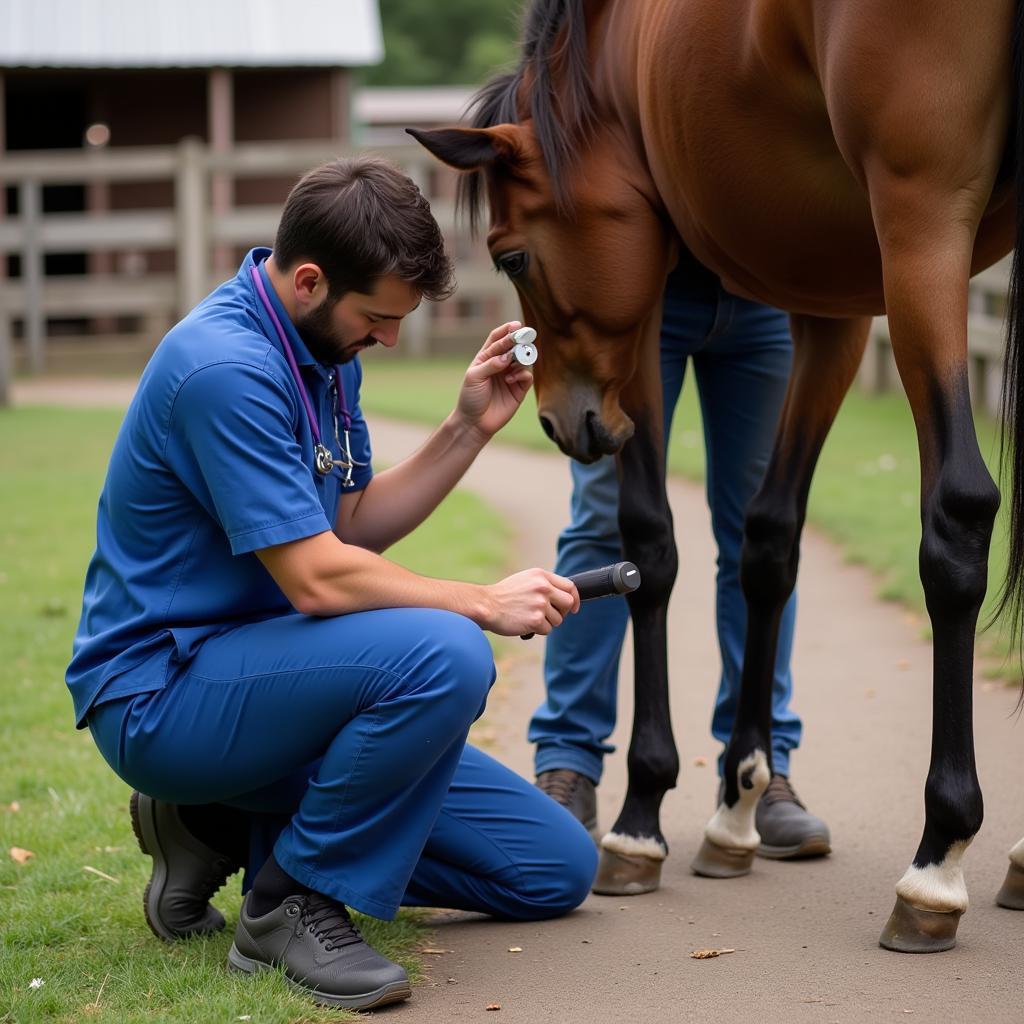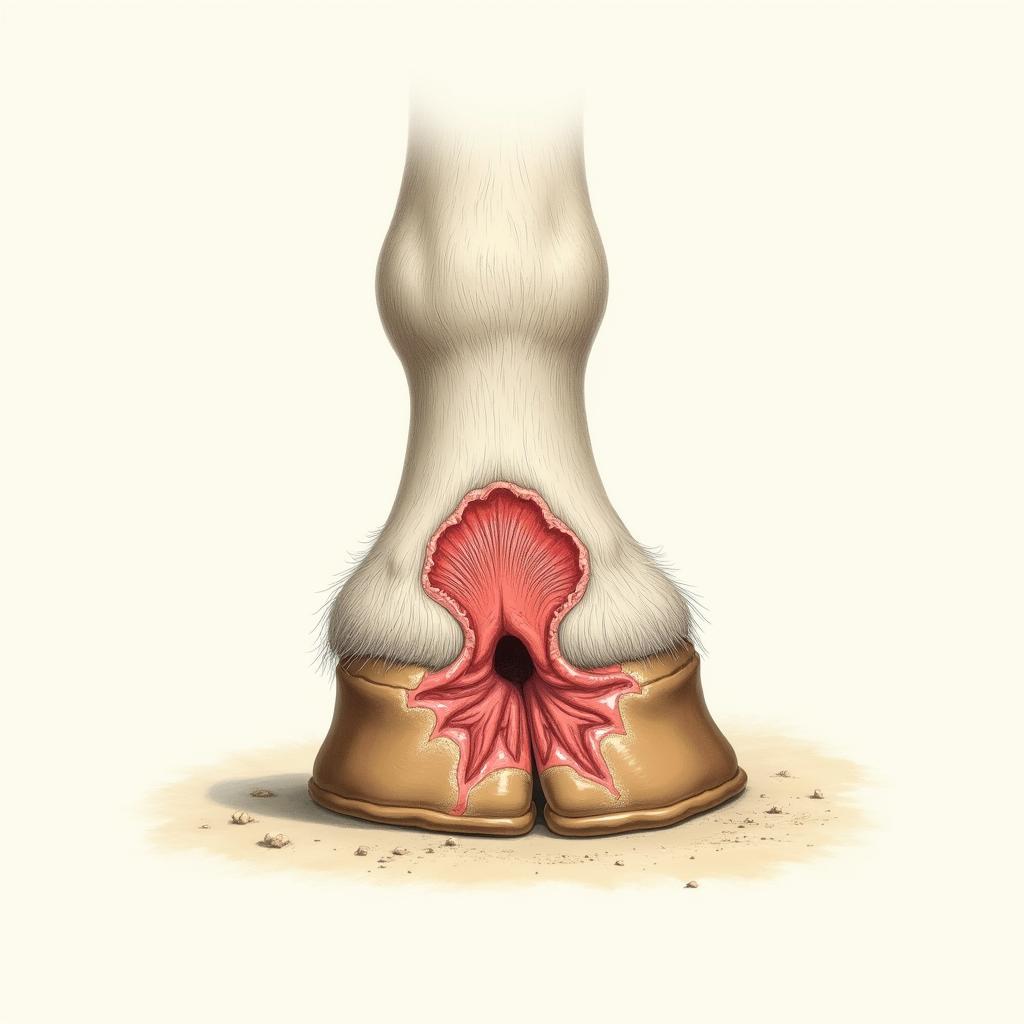A limping horse is every owner’s nightmare. This change in gait, a clear sign that something is wrong, can range from a mild annoyance to a serious problem. Understanding the potential causes of Horse Limping, recognizing the signs, and knowing when to call your veterinarian is crucial for ensuring your equine companion receives timely and appropriate care.
Decoding the Limp: What is Your Horse Telling You?
Horses can’t communicate their pain verbally, so they rely on physical cues. Limping is one of the most obvious ways they signal discomfort or injury. However, not all limps are created equal.
Types of Lameness:
- Supporting Limb Lameness: The horse puts less weight on the injured leg to minimize pain.
- Swinging Limb Lameness: The horse has difficulty moving the injured leg forward.
- Mixed Lameness: A combination of both supporting and swinging limb lameness.
Severity:
- Grade 1: Subtle lameness, difficult to detect except at a trot.
- Grade 2: Lameness is noticeable at a trot.
- Grade 3: Obvious lameness at a walk.
- Grade 4: The horse is reluctant to move or bear any weight on the affected limb.
- Grade 5: Non-weight-bearing lameness; the horse cannot use the limb at all.
 Veterinarian examining a horse's leg for lameness
Veterinarian examining a horse's leg for lameness
Common Culprits: Causes of Horse Limping
A wide range of issues can cause horse limping, from minor injuries to complex medical conditions. Here are some of the most common culprits:
1. Hoof Problems:
The hoof is often the first place to look when a horse starts limping.
- Abscesses: Painful infections within the hoof, usually caused by bacteria entering through a wound or crack.
- Bruises (Sole Bruises): Occur when the sole of the hoof is bruised by a rock or hard object.
- Thrush: A bacterial or fungal infection of the frog (the triangular part of the hoof).
- Laminitis: Inflammation of the laminae (tissues that attach the hoof wall to the pedal bone), often a serious and debilitating condition.
- Cracked Hooves: Can range from superficial cracks to deep fissures that cause pain and lameness.
 Cross-section illustration of a horse's hoof with an abscess
Cross-section illustration of a horse's hoof with an abscess
2. Leg Injuries:
Ligaments, tendons, and bones in a horse’s legs are susceptible to injury, especially during athletic activities.
- Tendonitis/Desmitis: Inflammation of the tendons or ligaments, often caused by strain or overuse.
- Splints: Bony growths on the cannon bone, common in young horses.
- Fractures: Breaks in the bone, ranging from small hairline fractures to complete breaks.
- Wounds and Punctures: Can introduce infection and cause pain and lameness.
3. Systemic Illnesses:
Sometimes, limping can be a symptom of an underlying illness or disease.
- Lyme Disease: A tick-borne illness that can cause joint pain and lameness.
- Equine Protozoal Myeloencephalitis (EPM): A parasitic infection that can affect the nervous system and cause neurological lameness.
When to Call the Vet: Recognizing an Emergency
While not all cases of limping are emergencies, some situations require immediate veterinary attention. Contact your vet immediately if your horse:
- Shows sudden, severe lameness.
- Is unable to bear weight on the affected limb.
- Has a visibly swollen or deformed leg.
- Has an open wound on the leg.
- Has a fever along with lameness.
- Shows signs of severe pain (e.g., sweating, trembling, rapid breathing).
Diagnosing the Problem: Your Vet’s Toolkit
Veterinarians use a variety of tools and techniques to diagnose the cause of horse limping:
- Physical Exam: Observing the horse at rest and in motion to assess gait abnormalities and palpate the legs for swelling, heat, or pain.
- Nerve Blocks: Injecting local anesthetic to numb specific areas of the leg to isolate the source of pain.
- Diagnostic Imaging:
- Radiographs (X-rays): To visualize bones and identify fractures, arthritis, or other bone abnormalities.
- Ultrasound: To examine soft tissues like tendons, ligaments, and muscles for injuries.
- Magnetic Resonance Imaging (MRI): To provide detailed images of bones, joints, and soft tissues.
 Veterinarian performing an ultrasound on a horse's leg
Veterinarian performing an ultrasound on a horse's leg
Treatment Options: Getting Your Horse Back on Track
The treatment for horse limping depends entirely on the underlying cause. Options include:
- Rest: For minor injuries, rest may be all that is needed.
- Medications:
- Non-steroidal Anti-inflammatory Drugs (NSAIDs): To reduce pain and inflammation.
- Antibiotics: To treat infections.
- Joint Supplements: To support joint health and cartilage regeneration.
- Therapeutic Shoeing: Corrective shoeing techniques to support the hoof and alleviate pain.
- Surgery: In some cases, surgery may be necessary to repair fractures, remove bone fragments, or address tendon or ligament injuries.
For a comprehensive look at therapeutic shoeing options, see our article on glue-on shoes for horses.
Preventing Lameness: Proactive Care for Soundness
While not all causes of horse limping are preventable, proactive care can significantly reduce the risk:
- Regular Hoof Care: Schedule farrier appointments every 6-8 weeks for trimming and shoeing.
- Proper Footing: Ensure pastures and paddocks have safe and even footing, free from rocks and holes.
- Gradual Conditioning: Avoid overworking your horse; gradually increase exercise intensity and duration.
- Warm-up and Cool-down: Always allow ample time for warm-up before exercise and cool-down afterward.
- Nutrition: Provide a balanced diet with adequate vitamins and minerals for optimal bone and joint health.
- Prompt Veterinary Attention: Address any signs of lameness early to prevent minor issues from becoming major problems.
To learn more about maintaining your horse’s hoof health, visit our article on how to wrap a horse hoof.
Conclusion: Your Horse’s Well-Being is Key
Horse limping can be a concerning experience for any horse owner. By understanding the potential causes, recognizing the signs, and seeking timely veterinary care, you can play a vital role in ensuring your horse’s swift recovery and long-term soundness. Remember, a proactive approach to your horse’s health is always the best strategy.
FAQs About Horse Limping
1. Can a horse limp from being overweight?
Yes, excess weight puts additional strain on a horse’s legs and joints, increasing the risk of lameness.
2. How long will it take for my horse’s lameness to resolve?
The healing time depends on the severity and cause of the lameness. It can range from a few days for minor injuries to weeks or even months for more serious conditions.
3. What is the best way to prevent abscesses in horses?
Regular hoof care, including picking out hooves daily, maintaining dry and clean stalls, and scheduling regular farrier appointments, can significantly reduce the risk of abscesses.
4. Can I use human pain relievers on my horse?
Never give human medications to your horse without consulting your veterinarian. Many human pain relievers are toxic to horses.
5. How can I tell if my horse’s lameness is an emergency?
Sudden onset, severe lameness, inability to bear weight, swelling, heat, open wounds, and signs of severe pain are all reasons to call your vet immediately.
6. What should I do if I suspect my horse has laminitis?
Laminitis is a serious condition that requires immediate veterinary attention. Contact your vet immediately if you suspect your horse might have laminitis.
7. Can lameness be a sign of a neurological problem?
Yes, certain neurological conditions, such as EPM, can cause lameness. These cases often present with other neurological symptoms, such as stumbling, incoordination, and muscle wasting.
Need More Help?
Do you have more questions or concerns about your horse’s health? Justus Horses USA is here to help. We offer a range of resources, including articles on horse ultrasound, the best antifungal shampoo for horses, and common issues like a horse lifting hind leg when standing.
For personalized guidance and expert advice, contact our team at:
Phone: 0772127271
Email: [email protected]
Address: QGM2+WX2, Vị Trung, Vị Thuỷ, Hậu Giang, Việt Nam
Our dedicated customer support team is available 24/7 to assist you.